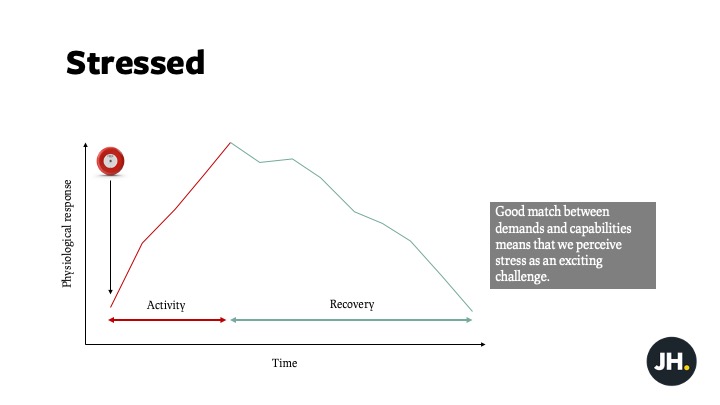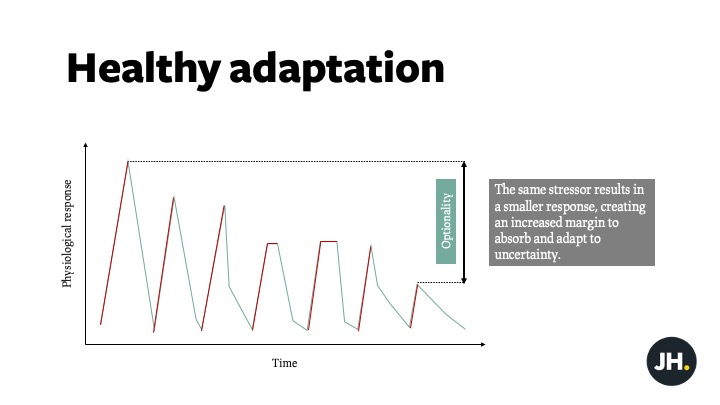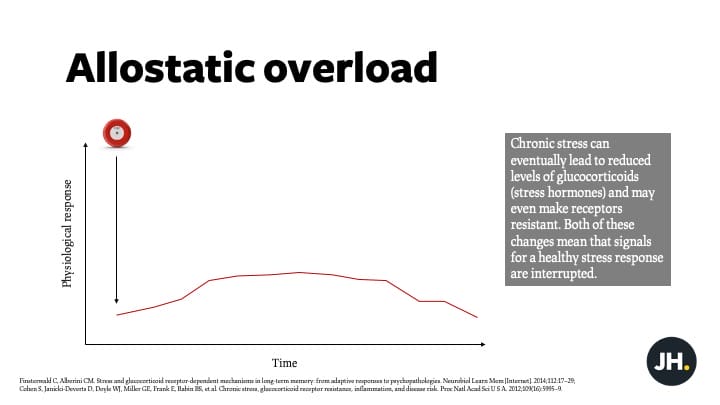Humans have an incredible capacity to adapt in the face of challenge, and we have an innate ability to manage and even thrive in stressful conditions. However, there is a difference between being stressed, and being stressed out. While some stress can be exciting and challenging, beyond a certain threshold and duration, stress can lead to deterioration in physiological and psychological systems, and subsequently, many of the diseases we see in modern life.
Read on to discover how you can develop the skills you need to maximise the probability of growing through challenges and uncertainty by achieving a healthy, adaptive response.
A state of dynamic equilibrium
Homeostasis is a familiar concept to many people. The word is derived from the Greek words ‘Homeo’ which means similar and ‘stasis’ which means state. Homeostasis describes the state of being in dynamic equilibrium, where there is a balance between the systems and processes in your body, which are critical for sustaining life. Physiological parameters such as blood glucose level, blood pressure and core body temperature are maintained with relative stability, within a small range.
Imagine you are riding a bicycle along a fast, smooth, gently twisting cycle path. You can see far ahead of you. The bike is stable, and you feel exhilarated and in control as you cruise around the corners. You may not notice it, but you are continually making tiny steering adjustments and subtly altering your position on the bike as you take the turns. These unconscious movements, which allow you to stay within the bounds of the path, are analogous to homeostasis.
Humans have an incredible capacity to adapt in the face of challenge
A related but distinct term, called allostasis, is probably less familiar but is more relevant to anti-fragility.
You can read more about the concept of antifragility.
The word allostasis is also derived from Greek, but this time from ‘Allo’ which means different. Allostasis is also used in the context of regulatory adjustments. However, allostasis encompasses a broader range of processes, beyond pure physiology, such as in your responses to social demands and stresses (1). Allostasis also emphasises the dynamism of adaptive responses to stress and how you achieve stability through change (2).
Again, imagine that you are riding your bicycle down a flat smooth cycle path. You approach a fork in the road and decide to take a new route that you have never considered before. Unexpectedly, the path pitches steeply downhill. Before you know it, you are speeding down a long, tight, twisting track. To avoid skidding into the barriers, you need to lean the bike over and apply the brakes in just the right place, at just the right time. Imagine that you are gripping the bars so tightly that your hands start to ache. You can hear the brakes begin to squeal as they wear down against the wheel rims.
This challenging deviation in your route, onto the steep descent that seems never-ending, is a metaphor for an allostatic state. You experience an allostatic state when there is a chronic deviation of your regulatory system from its normal, homeostatic operating level (3). This state is also associated with an accumulating burden of stress, called an allostatic load.
The difference between feeling stressed or stressed out
The allostatic load model provides a helpful framework to consider when your experience morphs from feeling stressed to ‘stressed out’. Some stress can be exciting and challenging, like riding a bike on a fast, smooth cycle path. Because you experience it as enjoyable, you may not even describe what you are feeling as stress, but technically it is.

In contrast, beyond a certain threshold, such as in experiences of ongoing worry, frustration or a persistent sense that the demands of your life are outstripping your capabilities, you will begin to feel stressed out (4).

When allostatic load becomes allostatic overload
Up to a point, accumulating allostatic load results in a healthy adaptation. As you adapt, the physiological and psychological response to a given level of stress decreases and the margin that you have available to absorb and adapt to uncertainty in the future increases.

However, an allostatic load that is too high, for too long, leads to deterioration in physiological and psychological systems, and subsequently, many of the diseases you see in modern life (5).
You can observe this process at a physiological level, in the relationship between your social environment, physical and mental health, which is mediated via your endocrine (hormonal), immune and autonomic nervous systems. These systems provide two-way communication between your brain and the body. Depending on the circumstances, these systems can exhibit a healthy and adaptive response to stress, or unhealthy, maladaptive response.
Hormones and stress response
Our hormonal response to stress provides a powerful illustration of the difference between feeling stressed and stressed out, as well as the progression from a healthy adaptive response, to a lack of adaptation and, eventually, to an overloaded system which is no longer able to respond adequately. Both lack of adaptation and lack of response means that signals for a healthy stress response are interrupted, akin to a cyclist with broken brakes.
Glucocorticoids and catecholamines are the primary hormones associated with the stress response. These hormones can have protective or damaging effects on the body, depending on the circumstances. In the short term, these hormones are essential for homeostasis and healthy adaptation to stress. Acute stress is associated with increases in the level of glucocorticoid hormone release. Receptors detect this increase and send signals which result in a healthy stress response. The hormones work like a cyclist applying the brakes on a descent in just the right place, at just the right time.
Eventually, the system is unable to respond
Over longer time intervals, the hormones that are essential for healthy adaptation are associated with a cost (allostatic load). Initially, while this load leads to a failure to adapt, the hormonal stress response continues. Imagine a cyclist who is gripping the bars too tightly and slamming on the brakes in every corner, instead of learning to ‘flow’ around the bends.

However, if the allostatic load is sustained at a high enough level, for long enough, the system starts to break down and is unable to respond (6). This phenomenon can be observed in instances of chronic stress, which can eventually lead to reduced levels of glucocorticoids (7) and may even make receptors resistant to the hormone (8). Imagine the cyclist again. As the descent continues, they fail to adapt, as they are too tense and braking too much. If the slope goes on for long enough, and the cyclist continues to grab the brakes in every corner, the brake pads begin to wear down. Eventually, the brake pads are so worn that they cannot brake enough. Now the cyclist has the opposite problem. Rather than braking too much, they can’t brake at all.

Becoming an antifragile performer
Humans, their teams and their organisations have a remarkable ability to respond and grow through stress and challenge, providing the foundations are in place. To achieve this adaptation and growth, you need to create the conditions and develop the skills you need to maximise the probability of growing through challenges and uncertainty by achieving a healthy, adaptive response.
While there are many factors outside of our control, there are some simple steps that you can take to prepare yourself and your organisation to use disruption and uncertainty as a fuel for growth in wellbeing and performance
- Body: Learn how you can increase the capacity of your body to adapt to challenges and buffer stress, by better understanding what aspects of your physiology are fragile, and what could be improved.
- Brain: Find out how to enhance your ability to benefit from uncertainty by using mental skills combined with techniques to regulate your nervous system.
- Behaviour: Discover why intentionally generating uncertainty, by taking small risks regularly, reduces resistance to change. Also, explore how psychological safety can unlock individual and team performance in the face of challenge.

Imagine a cyclist who masters the skills required to navigate fast, technical descents and even learn to enjoy them. While the ride isn’t without risk, they will feel confident and well equipped to handle a much wider variety of terrain. What once felt scary and too stressful now feels manageable, and new exciting challenges that once felt impossible are now within reach.
In future blogs, I’ll explore each of these three areas, brain, body and behaviour, in more detail.
References
1. Ramsay DS, Woods SC. Clarifying the roles of homeostasis and allostasis in physiological regulation. Psychol Rev. 2014;121(2):225–47.
2. Sterling, P., & Eyer J. Allostasis A new paradigm to explain arousal pathology. In S. Fisher, & J. Reason (Eds.), Handbook of life stress, cognition and health (pp. 629-649). New York John Wiley & Sons. – References – Scientific Research Publishing. 1988;(September). Available from: https://www.scirp.org/(S(351jmbntvnsjt1aadkposzje))/reference/ReferencesPapers.aspx?ReferenceID=846297
3. Koob GF. The role of CRF and CRF-related peptides in the dark side of addiction. Brain Res. 2010;1314:3–14.
4. McEwen BS. Stressed or stressed out: What is the difference? J Psychiatry Neurosci. 2005;30(5):315–8.
5. McEwen BS, Wingfield JC. Allostasis and Allostatic Load. In: Fink G, editor. Encyclopedia of Stress. 2nd ed. London: Academic Press; 2007. p. 135–41.
6. McEwen BS. Allostasis and allostatic load: Implications for neuropsychopharmacology. Neuropsychopharmacology. 1999;22(2):108–23.
7. Finsterwald C, Alberini CM. Stress and glucocorticoid receptor-dependent mechanisms in long-term memory: from adaptive responses to psychopathologies. Neurobiol Learn Mem [Internet]. 2014;112:17–29. Available from: https://www.ncbi.nlm.nih.gov/pmc/articles/PMC3624763/pdf/nihms412728.pdf
8. Cohen S, Janicki-Deverts D, Doyle WJ, Miller GE, Frank E, Rabin BS, et al. Chronic stress, glucocorticoid receptor resistance, inflammation, and disease risk. Proc Natl Acad Sci U S A. 2012;109(16):5995–9.





